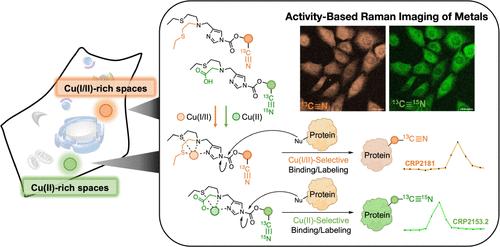An Activity-Based Sensing Approach to Multiplex Mapping of Labile Copper Pools by Stimulated Raman Scattering
IF 15.6
1区 化学
Q1 CHEMISTRY, MULTIDISCIPLINARY
引用次数: 0
Abstract
Molecular imaging with analyte-responsive probes offers a powerful chemical approach to studying biological processes. Many reagents for bioimaging employ a fluorescence readout, but the relatively broad emission bands of this modality and the need to alter the chemical structure of the fluorophore for different signal colors can potentially limit multiplex imaging. Here, we report a generalizable approach to multiplex analyte imaging by leveraging the comparably narrow spectral signatures of stimulated Raman scattering (SRS) in activity-based sensing (ABS) mode. We illustrate this concept with two copper Raman probes (CRPs), CRP2181 and CRP2153.2, that react selectively with loosely bound Cu(I/II) and Cu(II) ions, respectively, termed the labile copper pool, through copper-directed acyl imidazole (CDAI) chemistry. These reagents label proximal proteins in a copper-dependent manner using a dye scaffold bearing a 13C≡N or 13C≡15N isotopic SRS tag with nearly identical physiochemical properties in terms of shape and size. SRS imaging with the CRP reagents enables duplex monitoring of changes in intracellular labile Cu(I) and Cu(II) pools upon exogenous copper supplementation or copper depletion or genetic perturbations to copper transport proteins. Moreover, CRP imaging reveals reciprocal increases in labile Cu(II) pools upon decreases in activity of the antioxidant response nuclear factor-erythroid 2-related factor 2 (NRF2) in cellular models of lung adenocarcinoma. By showcasing the use of narrow-bandwidth ABS probes for multiplex imaging of copper pools in different oxidation states and identifying alterations in labile metal nutrient pools in cancer, this work establishes a foundation for broader SRS applications in analyte-responsive imaging in biological systems.

通过受激拉曼散射对易变铜池进行多重绘图的基于活性的传感方法
分析反应探针的分子成像为研究生物过程提供了一种强大的化学方法。许多用于生物成像的试剂都采用荧光读出,但这种成像方式的发射带相对较宽,而且需要改变荧光团的化学结构以获得不同的信号颜色,这可能会限制多重成像。在此,我们报告了一种利用基于活动的传感(ABS)模式下受激拉曼散射(SRS)的相对较窄的光谱特征进行多重分析成像的通用方法。我们用 CRP2181 和 CRP2153.2 这两种铜拉曼探针 (CRP) 来说明这一概念,它们通过铜定向酰基咪唑 (CDAI) 化学反应,分别与松散结合的 Cu(I/II) 和 Cu(II) 离子(称为易变铜池)发生选择性反应。这些试剂使用带有 13C≡N 或 13C≡15N 同位素 SRS 标签的染料支架,以铜依赖的方式标记近端蛋白质,其形状和大小的理化性质几乎完全相同。利用 CRP 试剂进行 SRS 成像,可以双工监测外源铜补充或铜耗竭或铜转运蛋白遗传扰动时细胞内可变型 Cu(I) 和 Cu(II) 池的变化。此外,在肺腺癌细胞模型中,当抗氧化反应核因子-红细胞2相关因子2(NRF2)的活性降低时,CRP成像揭示了可变铜(II)池的相互增加。通过展示使用窄带宽 ABS 探针对不同氧化态的铜池进行多重成像,并确定癌症中可移动金属营养池的变化,这项工作为 SRS 在生物系统分析响应成像中的更广泛应用奠定了基础。
本文章由计算机程序翻译,如有差异,请以英文原文为准。
求助全文
约1分钟内获得全文
求助全文
来源期刊
CiteScore
24.40
自引率
6.00%
发文量
2398
审稿时长
1.6 months
期刊介绍:
The flagship journal of the American Chemical Society, known as the Journal of the American Chemical Society (JACS), has been a prestigious publication since its establishment in 1879. It holds a preeminent position in the field of chemistry and related interdisciplinary sciences. JACS is committed to disseminating cutting-edge research papers, covering a wide range of topics, and encompasses approximately 19,000 pages of Articles, Communications, and Perspectives annually. With a weekly publication frequency, JACS plays a vital role in advancing the field of chemistry by providing essential research.

 求助内容:
求助内容: 应助结果提醒方式:
应助结果提醒方式:


